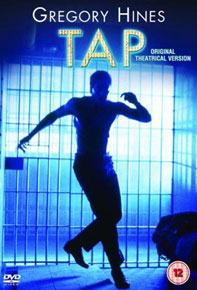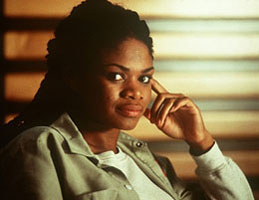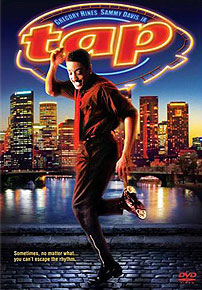 Some of the last of the great old tapdancers that Gregory Hines brought together in the film Tap (1989) were just such amazing old gents: Jimmy Slyde, Sandman Sims, Harold Nicholas, & Henry LeTang who did the lion's share of the tap choreography.
Some of the last of the great old tapdancers that Gregory Hines brought together in the film Tap (1989) were just such amazing old gents: Jimmy Slyde, Sandman Sims, Harold Nicholas, & Henry LeTang who did the lion's share of the tap choreography.
There's a story of sorts regarding Max (Hines) just out of Sing Sing Prison, who after angsty soul-searching decides to devote his life to dance rather than return to crime, & hopefully maturing enough to take advantage of the possibilities of love (with leading lady Suzanne Douglass as Amy).
The story is only adequate. But so what; all that really matters here is the dancing, whether hip old dudes showing one another their best moves, a precocious little genius (Savion Glover in his first acting role) already skilled enough to teach tap, or big almost enraged athletic numbers by Gregory Hines.
There's even a wonderful if small role for Sammy Davis, Jr., whose very real acting talent was effaced by a series of tacky roles in tacky films & by Rat Pack tokenism. As Little Mo in Tap he's brings guts, skill, & pathos to the screen.
Soonafter Tap was released, there was a brief fad in Seattle for taking tap lessons. A couple of my friends started wearing big-ass grampa shoes & just decided that dorky was cool that year. It may not have lasted, but it's a big impact for one film to have had.
And somehow I always felt Gregory would always be around through my lifetime, & one day be one of those amazing old gents himself. His early death was just such a terrible thing.
 I'd not seen Bojangles (2001) so one day when I was feeling down about Gregory being dead, I grabbed this film for a view. I'd not seen Bojangles (2001) so one day when I was feeling down about Gregory being dead, I grabbed this film for a view.
Now Gregory is so much larger a big hunk of an athlete than was Bill "Bojangles" Robinson, & Gregory's long legs can't really duplicate the elegantly retro tap style of the ragtime era, which was Bojangles' style.
But he can & does with a wink & a smile equal Bill's charismatic charm. And though he can't create a silhouette that looks like Bojangles, he sure can dance in his own way.
And Hines with his acting skill recreates most believably an aspect of Bill Robinson's character that is hard to see: the gun-toting, shit-kicking s.o.b. The Bojangles the public knew was not this troublemaking, self-destructive, hard-drinking gambling, lying womanizer.
The story of his relationship with Fanny (Kimberly Elise) is fun though as much a Hollywood romantic comedy as it is a biography. Boy meets girl, girl disdains boy, boy must give up quest for girl, then girl falls for boy. Not exactly drama. But they're both such cool actors it's fun to watch.
 In some scenes major characters like Fanny look straight into the camera & talk to the audience, so a certain artful artificiality falls over the film. In some scenes major characters like Fanny look straight into the camera & talk to the audience, so a certain artful artificiality falls over the film.
I don't know how much of the "history" to trust but Bill certainly was a dance innovator & I liked such "small" interior stories as how he "stumbled" upon his famous staircase dance, & similar vignettes regarding his growth as an entertainer.
Rightly trusting that Bill's life is worthy of drama, the dance scenes are mainly minimalized, though with enough dancing that it's still important. Bill becomes the highest paid black performer in America before the Depression. But the Depression kills Broadway, & Bill heads west to dance in movies with Shirley Temple.
He's willing to do the "shine" act of the happy dancing darkie, second fiddle to a preschooler, because he had been promised by studio head Darryl Zanuck (Jonathan Higgins) much less demeaning roles in the long run, if he'd stick it out with the stereotypical guest-spots for a while.
Those good roles that just never developed. When an activist visits Bill in his home on a day when he's hanging out with Perry Lincoln aka Stepin Fetchit (Richard Yearwood) & Hattie McDaniels (Quancetia Hamilton), the activist becomes downright meanspirited in blaming these successful actors for the stereotypes they permitted Hollywood to perpetuate, & this withdrawal of respect was to afflict Bojangles in his later years when the community made horrible "examples" of former leading lights.
The scene that followed this, in which Bo is harrassed by a charismatic Nation of Islam radical on a soapbox in a park, was very unpleasant & something of an overkill, besides just not well acted. The activist who came to his home & insulted him & his guests was sufficient to make this point.
And since the film does overlook signal moments in Bo's west coast experiences, the time could've been given over to showing, for important example, where Hollywood entertainers had to live in segregated times, in a neighborhood with a thrilling club scene that was like a second home to Bo.
Still, even with its faults & omissions, the film is in great part a tale of a quest for pride & respect in a racist world. Upon realizing Zanuck will never permit Bill to star in anything respectable, he walks out on his Hollywood career. And he could've been fully employed a long, long time if only he would concede to playing happy tapdancing porters & happy tapdancing shoeshine boys in a parade of cameo appearances.
Soon after we get a great scene set in Harlem of an aging Bill in a club setting, getting into a tapdancing duel with young men (including Savio Glover) who've updated tap considerably.
That's the first time Bill begins to feel like he's become history & not the top dog in the here & now. But then, low though his career seemed to be, there comes along Stormy Weather (1943), insuring him a permanent legacy on film.
Gregory duplicates Bojangles' famous staircase sequence from Stormy Weather complete with zoot suit choras line of boys & girls all extremely elegant. It almost seems like the film is going to end on a high note, but we will follow him unto his deathbed, with full knowledge that he died broke but not forgotten.
And the funeral parade through Harlem -- historical footage seen at beginning & end of the film -- is as much of a "happy" ending as we'll get.
Bojangles is not perfect, but it's not afflicted with biopicitis like most telefilms. It is a good drama. It has been called a "sanitized" biography since the truth of Bojangle's life & personality would much more wholeheartedly undo his best-known persona as Shirley Temple's servant & dance partner.
But I felt every aspect of his personality was allowed more than mere hints, & the fact was he was a greatly beloved man, & no reason to focus even more harshly on his gravest imperfections. For me it was mostly copasetic. Just please don't try to tell me Gregory, too, had an s.o.b. streak.
copyright © by Paghat the Ratgirl
|

